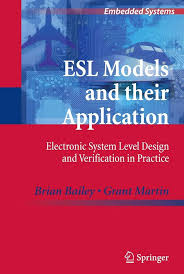Electronic System Level (ESL) Models: A Paradigm Shift in System Design
Introduction
The increasing complexity of electronic systems, driven by the relentless pursuit of higher performance, lower power consumption, and smaller form factors, has necessitated a radical shift in the traditional design methodologies. Electronic System Level (ESL) modeling offers a powerful solution to address these challenges by enabling designers to capture and analyze system behavior at a higher level of abstraction. This white paper delves into the core concepts of ESL models, their applications, and the transformative impact they have on the design and verification of complex electronic systems.
Understanding ESL Models
ESL models represent a system at a higher level of abstraction than traditional RTL (Register-Transfer Level) models. They focus on capturing the functional behavior of the system, rather than the detailed implementation details. This abstraction level allows designers to analyze system-level properties, such as performance, power consumption, and area, earlier in the design cycle.
Key Benefits of ESL Models
- Early System Exploration: ESL models enable designers to explore various design alternatives and architectural trade-offs at a higher level of abstraction, leading to faster time-to-market.
- Improved Design Quality: By identifying and addressing potential issues early in the design cycle, ESL models help to improve the overall quality and reliability of the final system.
- Enhanced System Verification: ESL models can be used to create comprehensive verification environments, including system-level testbenches and formal verification models, leading to more efficient and thorough verification.
- Accelerated System Integration: ESL models can facilitate the integration of different design components, such as hardware and software, by providing a unified platform for analysis and simulation.
Applications of ESL Models
ESL models have a wide range of applications across various domains of electronic system design:
- SoC Design: ESL models can be used to analyze the performance and power consumption of complex System-on-Chip (SoC) designs, leading to optimized architectures and improved system performance.
- Embedded Systems: ESL models can help in the design and verification of embedded systems, including automotive, aerospace, and medical devices.
- Wireless Communication Systems: ESL models can be used to analyze the performance of wireless communication systems, such as 5G and beyond, enabling the development of more efficient and reliable systems.
- AI and Machine Learning Accelerators: ESL models can help in the design and optimization of hardware accelerators for AI and machine learning applications, leading to higher performance and lower power consumption.
Challenges and Future Directions
While ESL modeling offers significant advantages, there are still challenges to overcome:
- Model Accuracy: Ensuring the accuracy of ESL models is crucial to obtain reliable results.
- Tool Interoperability: Effective integration of ESL tools with other design tools is essential for seamless design flows.
- Design Methodology Adoption: Wide adoption of ESL methodologies requires industry-wide standardization and education.
To address these challenges, ongoing research and development efforts are focused on improving the accuracy, efficiency, and interoperability of ESL tools. Additionally, the development of advanced modeling techniques, such as formal verification and machine learning-based approaches, will further enhance the capabilities of ESL models.
Conclusion
ESL models have emerged as a powerful tool for designing and verifying complex electronic systems. By enabling early system-level analysis and optimization, ESL models can significantly accelerate the design process and improve the quality of the final product. As the complexity of electronic systems continues to grow, ESL modeling will play an increasingly important role in ensuring the success of future designs.
References
- Gajski, D. D., Vahid, F., Narayan, S., & Gong, J. (2009). Specification and design of digital systems. Prentice Hall.
- Gupta, R., & Gupta, R. K. (2011). Principles of electronic design automation. Springer Science & Business Media.
- Bakoglu, H. B. (2015). Circuit theory and design. McGraw-Hill Education.
- Ciletti, M. D. (2017). Advanced digital design with Verilog HDL. Prentice Hall.
- IEEE Computer Society. (2018). IEEE Standard for SystemC Language Reference Manual. IEEE Std 1666-2011 (Revision IEEE Std 1666-2005). IEEE Computer Society.
By effectively leveraging ESL models, designers can unlock the full potential of complex electronic systems, leading to innovative products and solutions that shape the future of technology.



